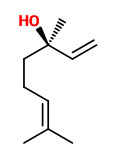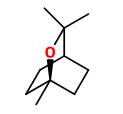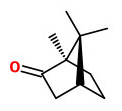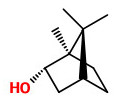Lavandula latifolia Medik. - Lamiaceae - broadleaf lavender, spike lavender, Breitblättriger Lavendel, Großer Speik, Spanischer Lavendel
Aromatic shrub, up to 80cm tall, native to the western Mediterranean region, cultivated and naturalized elsewhere; whole plant densely tomentulose; leaves lanceolate to linear, 2-4cm; flowers in terminal spikes, calyx tubular, straight, 5-6mm, corolla 1cm, pale lilac. http://www.efloras.org/florataxon.aspx?flora_id=2&taxon_id=200019758
Essential oils of spike lavender showed a significantly higher content of camphor and 1,8-cineole than lavender and lavandin oils. The limonene content is slightly increased and the linalyl acetate content (<1.8%) very low. Samples of authentic spike lavender oils contained 1,8-cineol of 41.7-48.0%; commercial oils had 27.3-46.3%. Authentic spike lavender oils contained campher 8.7-9.3%; commercial oils had 6.7-20.7%.
[Bilke, Stefanie. Natürliche Enantioselektivität und Isotopendiskriminierung–Schlüssel zur Echtheit ätherischer Öle. Diss. PhD thesis, 2002, 26-30]
„The composition of six essential oil samples, obtained by steam distillation of twigs of spike lavender (Lavandula latifolia Med.) harvested in three different locations from southern Spain during the full flowering and fruiting phenological stages, has been analyzed by capillary GC and GC/MS in combination with retention indices. Yields of the oils during flowering (1.5-2.2%) were 2.5-7 times higher than during fruiting (0.3-0.6%). Among the 56 identified constituents (accounting for 96.0-97.5% of the oils), the main and characteristic components were linalool (27.2-43.1%), 1,8-cineole (28.0-34.9%), camphor (10.8-23.2%), borneol (0.9-3.6%), β-pinene (0.8-2.6%), (E)-α-bisabolene (0.5-2.3%), β-pinene (0.6-1.9%), β-caryophyllene (0.5-1.9%), α-terpineol (0.8-1.6%), sabinene (0.3-0.8%), myrcene (0.3-0.8%), camphene (0.4-0.6%), terpinen-4-ol (0.3-0.5%) and limonene (0.2-0.9%). The volatile chemical composition and oil production of both full flowering and fruiting plants allowed to assess the type and quality of the spike lavender oils processed in the studied area.“
[Chemical composition and seasonal variations of spike lavender oil from Southern Spain., Salido, S., Altarejos, J., Nogueras, M., Sánchez, A., Luque, P., Journal of Essential Oil Research, Vol.16(3), 2004, 206-210]
„The essential oil of Lavandula latifolia collected from the North of Tunisia was isolated by steam distillation… A total of 40 compounds were identified in the flower parts oil, the principal components being linalool (32.3%), camphor (12.4%), 1,8-cineole (11.7%), lavandulol (8.7%), p-cymen-8-ol (7.7%) and bornyl acetate (4.2%).“
[Analysis of the essential oil of Lavandula latifolia from Tunisia., Alatrache, A., Jamoussi, B., Tarhouni, R., Abdrabba, M., Journal of Essential Oil Bearing Plants, Vol.10(6), 2007, 446-452]
The composition of the essential oil of the flowers (spike lavender oil) in seven natural populations of Lavandula latifolia from the eastern Iberian Peninsula was analysed and suggests the existence of three groups of
essential oils with high, intermediate and low percentage of linalool, respectively.
Group I possesses linalool-rich oils (42-54%), with the lowest percentage of camphor (11-13%) and 20-28% of cineole. Group II, whose oils have an intermediate proportion of linalool (31-36%) and higher percentages of camphor (15-18%), limonene, β-caryophyllene and borneol, whereas cineole percentages range from 28 to 34%. The group III is characterized on the one hand by the highest percentage (47.9%) of cineole and on the other hand by their richness in α- and β-pinene, sabinene, myrcene, and sabinene hydrate, but the lowest linalool content (15.1%) and a 16.5% of camphor. Lavandulyl acetate was completely absent in all oils and lavandulol content was 0.2-1.0%.
[Essential oil variation within and among natural populations of Lavandula latifolia and its relation to their ecological areas., Muñoz-Bertomeu, J., Arrillaga, I., Segura, J., Biochemical systematics and Ecology, Vol.35(8), 2007, 479-488]
„The monoterpene alcohol (-)-(R)-lavandulol and its acetate can be considered as biogenic internal standards for lavender/lavandin oils, because these irregular isoprenoids are not found in spike oil.“
[Scent and Chemistry, Günther Ohloff, Wilhelm Pickenhagen, Philip Kraft, Wiley-VCH, 2012, 243]
From the forty compounds identified in hydrodistilled oils of dried L.latifolia growing wild in Spain, three (1,8-cineole, linalool and camphor) accounting for more than 70% of the total oil. Linalool and camphor were inversely correlated. The ranges found were limonene 0-3.4%, 1,8-cineole 6.6-57.1%, camphor 1.1-46.7%, linalool 3.7-61.1%, linalyl acetate 0-0.8%, α-terpineol 0-2.9%.
[Chemical characterization of Lavandula latifolia Medik. essential oil from Spanish wild populations., Herraiz-Peñalver, D., Cases, M.Á., Varela, F., Navarrete, P., Sánchez-Vioque, R., Usano-Alemany, J., Biochemical Systematics and Ecology, 46, 2013, 59-68]

Lavandula latifolia Medik. as Spica latifolia
Blackwell, E., Herbarium Blackwellianum, vol.3, t.295 (1757) plantgenera.org

Lavandula latifolia, Huesca, Spain (2024) © Pedro Antonio Lázaro Molinero CC BY-SA 4.0 inaturalist.org



